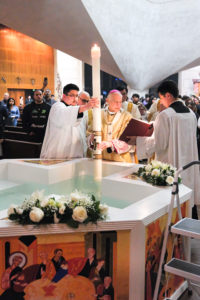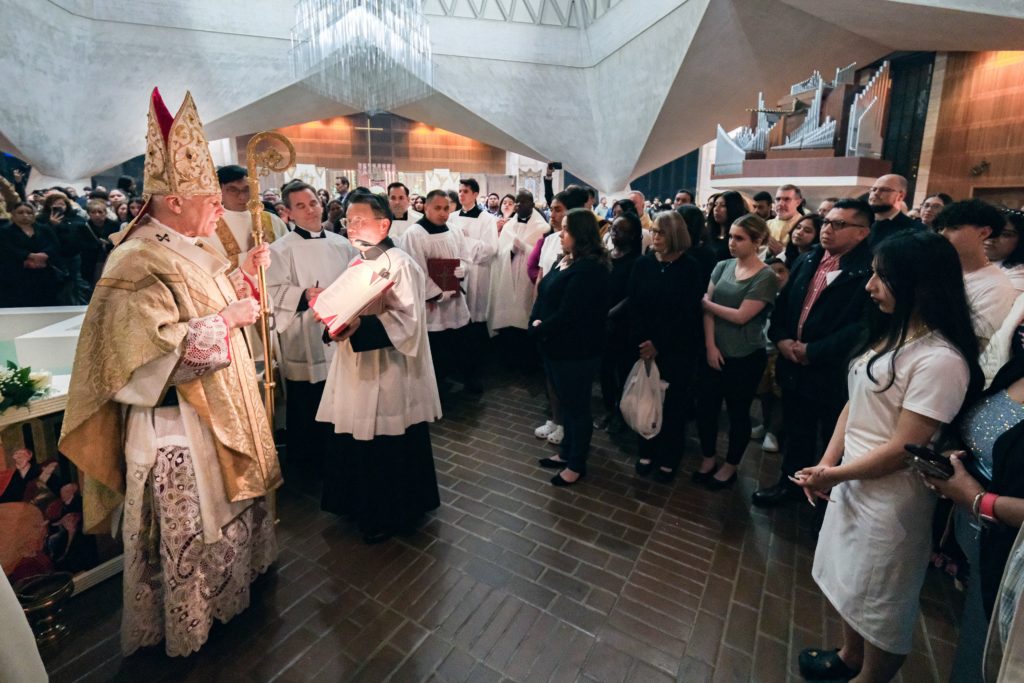Initiation into the Catholic faith as an adult often involves a yearslong process of discernment and formation leading up to one life-changing moment: baptism.
It’s a moment that Archbishop Salvatore Cordileone of San Francisco believes should be expressed more “forcefully and convincingly.” So this year, at his cathedral’s Easter Vigil liturgy, he incorporated some rarely used elements of the rite of baptism that date back to the first centuries of Christianity.
In a phone interview, Cordileone explained the symbolism of the changes and shared his thoughts on what’s behind the apparent rise in adult conversions to Catholicism.
Archbishop, you did baptisms at your Easter Vigil this year a little differently. What did you change, and why?
The Church has always drawn spiritual lessons from space and time. The symbolism of east and west, for example, was part of an ancient practice when Christians being baptized renounced sin and professed their faith.
First, the catechumens and I stood on the west side of the baptismal font, with them facing west (toward me) as they did the renunciation of sin. The west is the last place where the light of the sun arrives, so it's a place of darkness. So, renouncing sin is renouncing the darkness.
Then I walked to the other side and they turned around and faced toward the east (toward me) to profess their faith, because east is the source of light, where the sun rises. The rising sun symbolizes Christ rising from the dead, dispelling the darkness of sin and death. The east is also symbolic of paradise, where God created man and woman. The garden, located in the east, symbolizes the Christian journey from this world to the light of God’s kingdom.
Another detail: This year, with help from local communities of the Neocatechumenal Way, we had an immersion baptismal font built in front of the regular font at St. Mary of the Assumption Cathedral here in San Francisco. On the sides there are icons painted in the style of Kiko Argüello, a Spanish artist who started the Neocatechumenal Way.
So, after professing their faith, the catechumens climbed a stepladder to enter the baptismal font from the west side. They went three steps down into the water and were immersed three times, symbolizing the three days Christ spent in the tomb. Then they walked three steps back up, symbolizing their being united with Christ in his resurrection.
St. Cyril of Jerusalem (313-386 AD) spoke about these signs, telling Christians that “when you were immersed in the water it was like night for you and you could not see; but when you rose again it was like coming into broad daylight. In the same instant you died and were born again; the saving water was both your tomb and your mother.”

You had 17 adult baptisms at this year’s vigil. For the sake of time, why not just pour a little water on their foreheads, if the sacrament is just as valid?
Validity is a pretty low bar to determine how we celebrate the sacraments. Think of a married couple celebrating their wedding anniversary: You can take your wife to McDonald’s, or you can have a special candlelight dinner. They’re both meals, ways to mark your anniversary. But which one is really proper to the occasion?
Baptism is the door to all of the other sacraments. Yes, it’s a lot of heavy lifting to do a baptism by immersion — especially with the number of adults this year — but it’s very profound. The meaning of the sacrament is conveyed so much more forcefully and convincingly.
A couple of my traditionally minded friends were kind of suspicious about this idea of baptism by immersion. But what they saw at the Easter Vigil changed their minds, because they saw what it conveys and that it’s authentically within our tradition. In fact, we know from his writings that this was how baptisms were done in St. Cyril’s time.
Your diocese, like many others around the country, saw a rise in adult baptisms this year. What do you think is behind it?
A lot of what I hear is anecdotal, but do I know that we’ve been emphasizing that faith has to be a personal encounter.
I recently had dinner with FOCUS missionaries serving here at San Francisco State University. And they’ll do things like play frisbee on the lawn and the students will come over and talk to them, and are surprised that they are Catholic missionaries.
I would imagine the whole COVID-19 experience was part of it, too: People realized that we need in-person community, that virtual doesn’t work.
I also wonder whether everything going on in society — the dehumanization, the different ideologies, the role of social media — kind of aggravates the sense of isolation, which leads to depression and anxiety. People are realizing that there must be a better way, and that it goes beyond this idea of being spiritual but not religious: They realize spirituality has to be within the context of a community of faith. My gut feeling is that these things have something to do with it.

